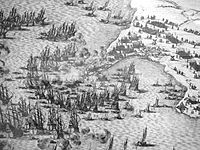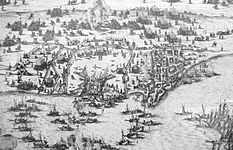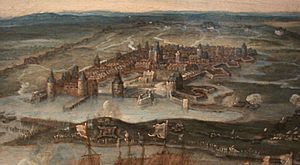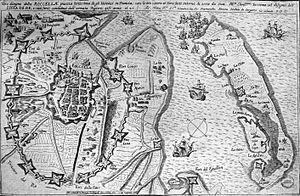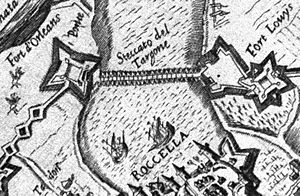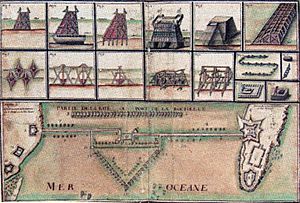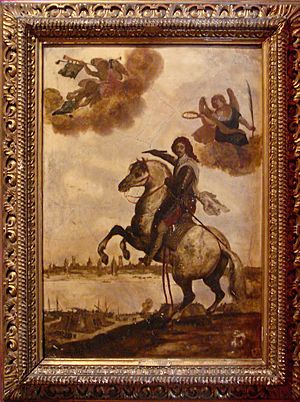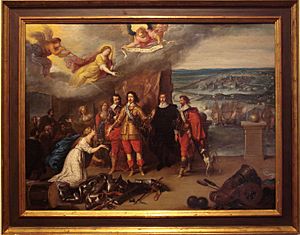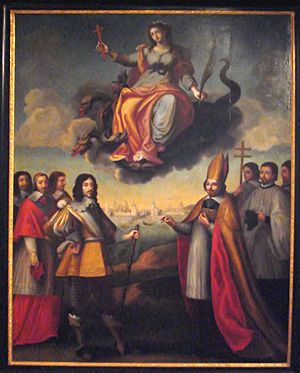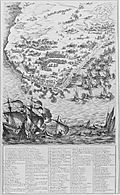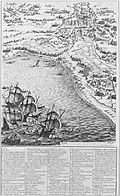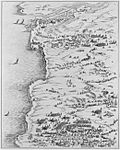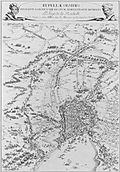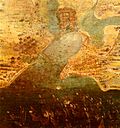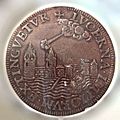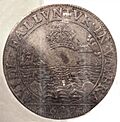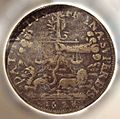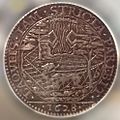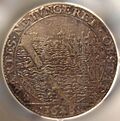Siege of La Rochelle facts for kids
Quick facts for kids Siege of La Rochelle (1627–1628)Siège de La Rochelle (1627–1628) |
|||||||
|---|---|---|---|---|---|---|---|
| Part of the Huguenot rebellions and the Anglo-French War (1627–1629) | |||||||
 Cardinal Richelieu on the Sea Wall of La Rochelle at the time of the siege |
|||||||
|
|||||||
| Belligerents | |||||||
| Commanders and leaders | |||||||
| Strength | |||||||
| Siege Army: 22,001 Toiras: 1,200 alongside 30-40 Spanish ships |
La Rochelle: 27,000 civilians and soldiers Buckingham: 80 ships, 7,000 soldiers |
||||||
| Casualties and losses | |||||||
| Siege Army: ? Toiras: 500 killed |
La Rochelle: 22,000 killed Buckingham: 5,000 killed |
||||||
The Siege of La Rochelle was a big fight in France between 1627 and 1628. It happened between the French King Louis XIII's army and the Huguenots of La Rochelle. Huguenots were French Protestants. This siege was a major event in the struggle between Catholics and Protestants in France. In the end, King Louis XIII and his Catholic forces won completely.
Contents
Why the Siege Happened
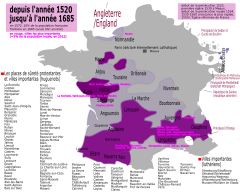
After many religious wars, the Edict of Nantes in 1598 gave Protestants, or Huguenots, a lot of freedom. They could govern themselves in certain areas. La Rochelle was a very important city for the Huguenots. It was a strong port and a center of their power against the Catholic king.
In 1610, King Henry IV of France was killed. His young son, Louis XIII, became king. His mother, Marie de' Medici, ruled for him at first. When she was removed in 1617, many nobles, both Catholic and Protestant, rebelled. Religious tensions grew even more because of the Thirty Years War starting in 1618.
In 1621, King Louis XIII brought Catholicism back to the Huguenot region of Béarn. This caused a new uprising led by Henri de Rohan and his brother Soubise. The king's forces captured Saint-Jean d'Angély, but they couldn't fully block La Rochelle. The fighting ended in 1622 with the Treaty of Montpellier.
Taking La Rochelle was a top goal for King Louis XIII and his main advisor, Cardinal Richelieu. La Rochelle was one of France's largest cities, with over 30,000 people. It was also a very important port. The city earned a lot of money from trade and salt production, which brought taxes to the king.
Richelieu wanted to make the king's power stronger across France. To do this, he needed to defeat Rohan and take La Rochelle. France didn't have a strong enough navy to capture the city by sea. So, Richelieu asked England for help, but King James I said no. Then, he asked the Dutch Republic. The Dutch were fighting Spain for their freedom. In exchange for money from France, the Dutch agreed to help with their navy in 1624.
England's Involvement
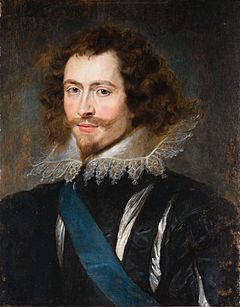
England and France had been allies, but things changed. In 1626, France made a secret peace deal with Spain. Also, France was building a stronger navy. England worried about France's growing power.
In 1626, an English agent named Walter Montagu went to France. He tried to get French nobles to rebel against the king. The plan was for an English fleet to arrive and start a new Huguenot revolt. This revolt would be led by Duke Henri de Rohan and his brother Soubise.
First English Attack
Right image: English forces in the siege of Saint-Martin-de-Ré.
King Charles I of England sent a fleet of over 100 ships. His favorite, George Villiers, 1st Duke of Buckingham, led this fleet. In June 1627, Buckingham landed 6,000 men on the nearby island of Île de Ré. His goal was to help the Huguenots and start the Anglo-French War of 1627. He wanted to control the sea around La Rochelle and encourage the city to rebel.
However, La Rochelle at first did not want to openly join Buckingham against the French king. They even stopped Buckingham's fleet from entering their harbor. La Rochelle only openly joined the English in September, when fighting began between the city and the king's troops.
Île de Ré was a Protestant area, but it had not joined the rebellion. Buckingham's English forces tried to capture the fortified city of Saint-Martin on the island. This was called the siege of Saint-Martin-de-Ré (1627). After three months, they were pushed back. Small French boats managed to bring supplies to Saint-Martin despite the English blockade. Buckingham's army ran out of money and supplies, and many soldiers got sick. After a final attack that caused heavy losses, the English left with their ships.
The Siege of La Rochelle Begins
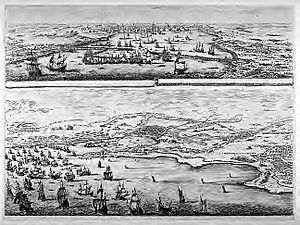

In August 1627, the French royal army began to surround La Rochelle. This army had 7,000 soldiers, 600 horses, and 24 cannons. Charles of Angoulême led them. They started building up defenses at Bongraine (now Les Minimes) and at Fort Louis.
On September 10, La Rochelle fired its first cannon shots at the royal troops at Fort Louis. This started the third Huguenot rebellion. La Rochelle was the strongest Huguenot city in France and the center of their fight. When the King was away, Cardinal Richelieu took charge of the siege.
French engineers built a long line of trenches and forts around the city. This line was about 12 kilometers (7.5 miles) long. It had 11 forts and 18 smaller forts. These defenses were finished by April 1628, and 30,000 soldiers guarded them.
Workers also built a huge seawall, 1,400 meters (0.87 miles) long. This wall blocked the sea access to the city's harbor. It stopped all supplies from reaching La Rochelle by sea. An Italian engineer, Pompeo Targone, first suggested the idea. But his first wall broke in winter storms. Then, the royal architect Clément Métezeau took over in November 1627. He built the wall on a base of sunken ships filled with rocks. French cannons fired at English ships that tried to bring supplies to the city.
Meanwhile, in southern France, Henri de Rohan tried to start a rebellion to help La Rochelle, but he failed. Until February, some ships could get through the unfinished seawall. But after March, the city was completely blocked. The only hope for La Rochelle was if an English fleet could break through.
Help for the French King
Dutch Help
The Catholic French government rented ships from the Protestant city of Amsterdam in the Netherlands. These ships were used to attack the Protestant city of La Rochelle. There was a debate in Amsterdam about whether French Catholic soldiers should be allowed to have a Catholic church service on the Dutch Protestant ships. They decided it was not allowed. The Dutch ships then took the French soldiers to La Rochelle. France and the Netherlands were allies against the Habsburgs at that time.
Spanish Alliance
During the siege, Spain and France worked together against their common enemies: England, the Huguenots, and the Dutch. Richelieu accepted Spain's help. A Spanish fleet of 30 to 40 warships sailed from Cadiz to the Gulf of Morbihan. They arrived three weeks after Buckingham left Île de Ré. The Spanish fleet anchored in front of La Rochelle for a while, showing their support, but they did not actually fight the city.
England's Attempts to Help
England tried to send two more fleets to help La Rochelle.
Second English Fleet
A fleet led by William Feilding, the Earl of Denbigh, left in April 1628. But it returned to Portsmouth without fighting. Denbigh said he was not allowed to risk the king's ships in a battle.
Third English Fleet
A third fleet was sent in August 1628. It had 29 warships and 31 merchant ships. The Earl of Lindsey led this fleet. In September 1628, the English fleet tried to help the city. They fired cannons at the French positions. But they could not break through the strong seawall. The English fleet had to leave. After this last failure, the city of La Rochelle surrendered on October 28, 1628.
After the Siege
The people of La Rochelle fought for 14 months. Their mayor, Jean Guitton, led them. England sent less and less help over time. During the siege, the population of La Rochelle dropped from 27,000 to just 5,000. Many people died from fighting, hunger, and sickness.
La Rochelle surrendered without any conditions. The Peace of Alais agreement meant the Huguenots lost their land, political power, and military rights. However, they kept their religious freedom, which was given by the Edict of Nantes. But they were now completely under the king's control. This meant they could not fight back later when Louis XIV took away the Edict of Nantes and started to persecute Protestants.
The Siege of La Rochelle was more than just a religious battle. It was a big step in making the French government strong and central. The king gained full control over his territory. This event helped create the absolute monarchy in France. Its effects can still be seen in French history today.
The French thinker Descartes visited the siege site in 1627. The siege was shown in many artworks, like paintings by Jacques Callot and the 1635 painting Louis XIII Crowned by Victory.
Images for kids
-
Plate 2: the sea wall and Les Minimes.
-
Plate 5: overview of La Rochelle surrounded.
-
City of La Rochelle and fortifications during the siege, anonymous, 17th century, Versailles.
-
Siege of La Rochelle by Claude Lorrain, Le Louvre.
-
The Siege of La Rochelle by Jacques Callot, with the English fleet of the Earl of Lindsey approaching.


